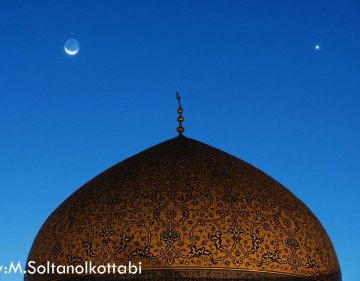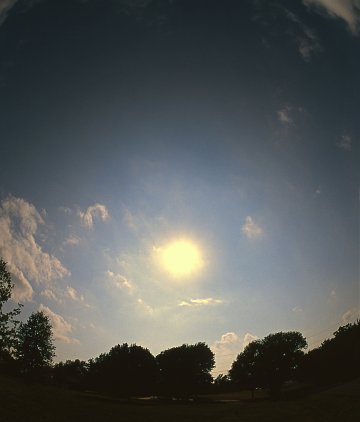 Where's Saturn? Is that a UFO--or the ISS? What's the name of that star? Get the answers from mySKY--a fun new astronomy helper from Meade. . Where's Saturn? Is that a UFO--or the ISS? What's the name of that star? Get the answers from mySKY--a fun new astronomy helper from Meade. . MARS UPDATE: Two months after sky-darkening dust from severe storms nearly killed NASA's Mars exploration rovers, the solar powered robots are alive and well and ready to continue their missions. Next up: Opportunity begins its risky descent into Victoria crater on Sept. 11th: more. GOOD MORNING: Once a month in Esfahan, Iran, the day begins with the crescent Moon hovering next to the ancient Sheikh Lotf Allah Mosque. This morning, Venus was there, too. Mohamad Soltanolkottabi was on the scene, camera ready, to photograph the ensemble: 
More mosque images: #1, #2, #3, #4
Thousands of miles away in Albany, Missouri, the scene repeated itself with one difference: the International Space Station took the place of the mosque. Dan Bush used his Nikon D70 to capture the picture. "The ISS flared in brightness, as can be seen in the unequal brightness of its trail," he notes. All in all, it was a good day to wake up at dawn. More images: from Michael Boschat of Halifax, Nova Scotia, Canada. BISHOP'S RING: " I stepped outside of work at 4:00 pm today, and noticed a rather bright blue aureole around the sun with a radius similar to a garden variety solar halo, bordered by a faint yellowish corona," says Doug Zubenel of Johnson County, Kansas. "The darkness of the photo's corners is due to the drop in brightness of the sky outside the halo - no vignetting from the lens is occurring at all." (continued below) 
Photo details: Nikon FM2, 16mm Nikkor fisheye lens, f/8, 1/500 sec, Fuji Velvia 50
This phenomenon is called a Bishop's Ring. "It is essentially a corona
produced by very small (1 micron or less) particles or droplets," explains atmospheric optics expert Les Cowley. "A large volcano injecting fine ash into the stratosphere can produce these effects for years." There haven't been any big eruptions lately. Instead, suggests Cowley, this Bishop's Ring may have been caused by a distant wildfire wafting its ash over middle America. "We shall likely never know!" he says. Consider it a beautiful mystery. more images: from Martin Popek of the Czech Republic.
September 2007 Aurora Gallery
[August 2007 Aurora Gallery] [Night-sky Cameras] | 
